SAME SEX MARRIAGE ACT 2014
VerifiedAdded on 2022/08/16
|6
|1450
|11
AI Summary
Contribute Materials
Your contribution can guide someone’s learning journey. Share your
documents today.

Marriage Act, 2014
Student Details
1-1-2020
Student Details
1-1-2020
Secure Best Marks with AI Grader
Need help grading? Try our AI Grader for instant feedback on your assignments.
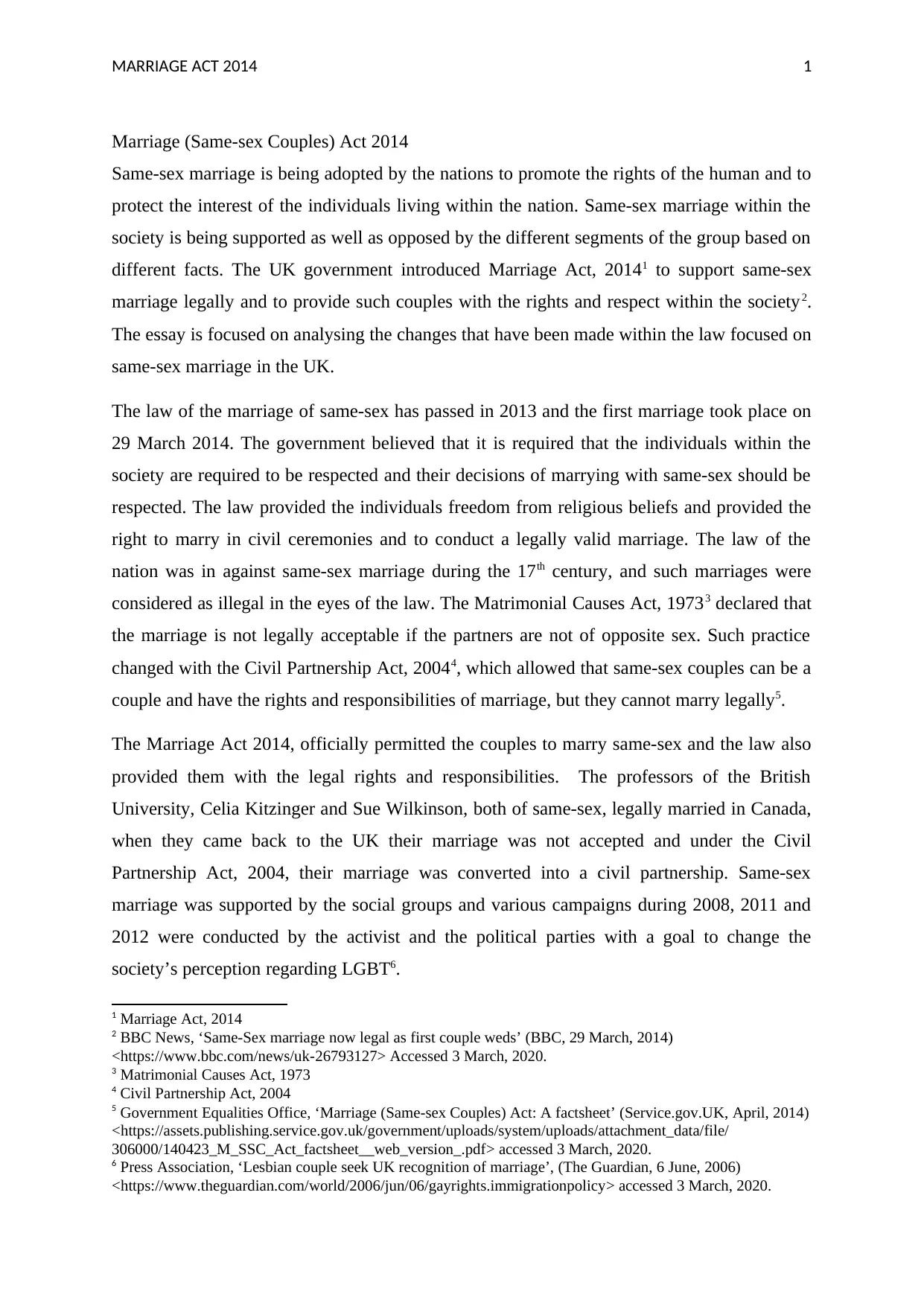
MARRIAGE ACT 2014 1
Marriage (Same-sex Couples) Act 2014
Same-sex marriage is being adopted by the nations to promote the rights of the human and to
protect the interest of the individuals living within the nation. Same-sex marriage within the
society is being supported as well as opposed by the different segments of the group based on
different facts. The UK government introduced Marriage Act, 20141 to support same-sex
marriage legally and to provide such couples with the rights and respect within the society2.
The essay is focused on analysing the changes that have been made within the law focused on
same-sex marriage in the UK.
The law of the marriage of same-sex has passed in 2013 and the first marriage took place on
29 March 2014. The government believed that it is required that the individuals within the
society are required to be respected and their decisions of marrying with same-sex should be
respected. The law provided the individuals freedom from religious beliefs and provided the
right to marry in civil ceremonies and to conduct a legally valid marriage. The law of the
nation was in against same-sex marriage during the 17th century, and such marriages were
considered as illegal in the eyes of the law. The Matrimonial Causes Act, 19733 declared that
the marriage is not legally acceptable if the partners are not of opposite sex. Such practice
changed with the Civil Partnership Act, 20044, which allowed that same-sex couples can be a
couple and have the rights and responsibilities of marriage, but they cannot marry legally5.
The Marriage Act 2014, officially permitted the couples to marry same-sex and the law also
provided them with the legal rights and responsibilities. The professors of the British
University, Celia Kitzinger and Sue Wilkinson, both of same-sex, legally married in Canada,
when they came back to the UK their marriage was not accepted and under the Civil
Partnership Act, 2004, their marriage was converted into a civil partnership. Same-sex
marriage was supported by the social groups and various campaigns during 2008, 2011 and
2012 were conducted by the activist and the political parties with a goal to change the
society’s perception regarding LGBT6.
1 Marriage Act, 2014
2 BBC News, ‘Same-Sex marriage now legal as first couple weds’ (BBC, 29 March, 2014)
<https://www.bbc.com/news/uk-26793127> Accessed 3 March, 2020.
3 Matrimonial Causes Act, 1973
4 Civil Partnership Act, 2004
5 Government Equalities Office, ‘Marriage (Same-sex Couples) Act: A factsheet’ (Service.gov.UK, April, 2014)
<https://assets.publishing.service.gov.uk/government/uploads/system/uploads/attachment_data/file/
306000/140423_M_SSC_Act_factsheet__web_version_.pdf> accessed 3 March, 2020.
6 Press Association, ‘Lesbian couple seek UK recognition of marriage’, (The Guardian, 6 June, 2006)
<https://www.theguardian.com/world/2006/jun/06/gayrights.immigrationpolicy> accessed 3 March, 2020.
Marriage (Same-sex Couples) Act 2014
Same-sex marriage is being adopted by the nations to promote the rights of the human and to
protect the interest of the individuals living within the nation. Same-sex marriage within the
society is being supported as well as opposed by the different segments of the group based on
different facts. The UK government introduced Marriage Act, 20141 to support same-sex
marriage legally and to provide such couples with the rights and respect within the society2.
The essay is focused on analysing the changes that have been made within the law focused on
same-sex marriage in the UK.
The law of the marriage of same-sex has passed in 2013 and the first marriage took place on
29 March 2014. The government believed that it is required that the individuals within the
society are required to be respected and their decisions of marrying with same-sex should be
respected. The law provided the individuals freedom from religious beliefs and provided the
right to marry in civil ceremonies and to conduct a legally valid marriage. The law of the
nation was in against same-sex marriage during the 17th century, and such marriages were
considered as illegal in the eyes of the law. The Matrimonial Causes Act, 19733 declared that
the marriage is not legally acceptable if the partners are not of opposite sex. Such practice
changed with the Civil Partnership Act, 20044, which allowed that same-sex couples can be a
couple and have the rights and responsibilities of marriage, but they cannot marry legally5.
The Marriage Act 2014, officially permitted the couples to marry same-sex and the law also
provided them with the legal rights and responsibilities. The professors of the British
University, Celia Kitzinger and Sue Wilkinson, both of same-sex, legally married in Canada,
when they came back to the UK their marriage was not accepted and under the Civil
Partnership Act, 2004, their marriage was converted into a civil partnership. Same-sex
marriage was supported by the social groups and various campaigns during 2008, 2011 and
2012 were conducted by the activist and the political parties with a goal to change the
society’s perception regarding LGBT6.
1 Marriage Act, 2014
2 BBC News, ‘Same-Sex marriage now legal as first couple weds’ (BBC, 29 March, 2014)
<https://www.bbc.com/news/uk-26793127> Accessed 3 March, 2020.
3 Matrimonial Causes Act, 1973
4 Civil Partnership Act, 2004
5 Government Equalities Office, ‘Marriage (Same-sex Couples) Act: A factsheet’ (Service.gov.UK, April, 2014)
<https://assets.publishing.service.gov.uk/government/uploads/system/uploads/attachment_data/file/
306000/140423_M_SSC_Act_factsheet__web_version_.pdf> accessed 3 March, 2020.
6 Press Association, ‘Lesbian couple seek UK recognition of marriage’, (The Guardian, 6 June, 2006)
<https://www.theguardian.com/world/2006/jun/06/gayrights.immigrationpolicy> accessed 3 March, 2020.
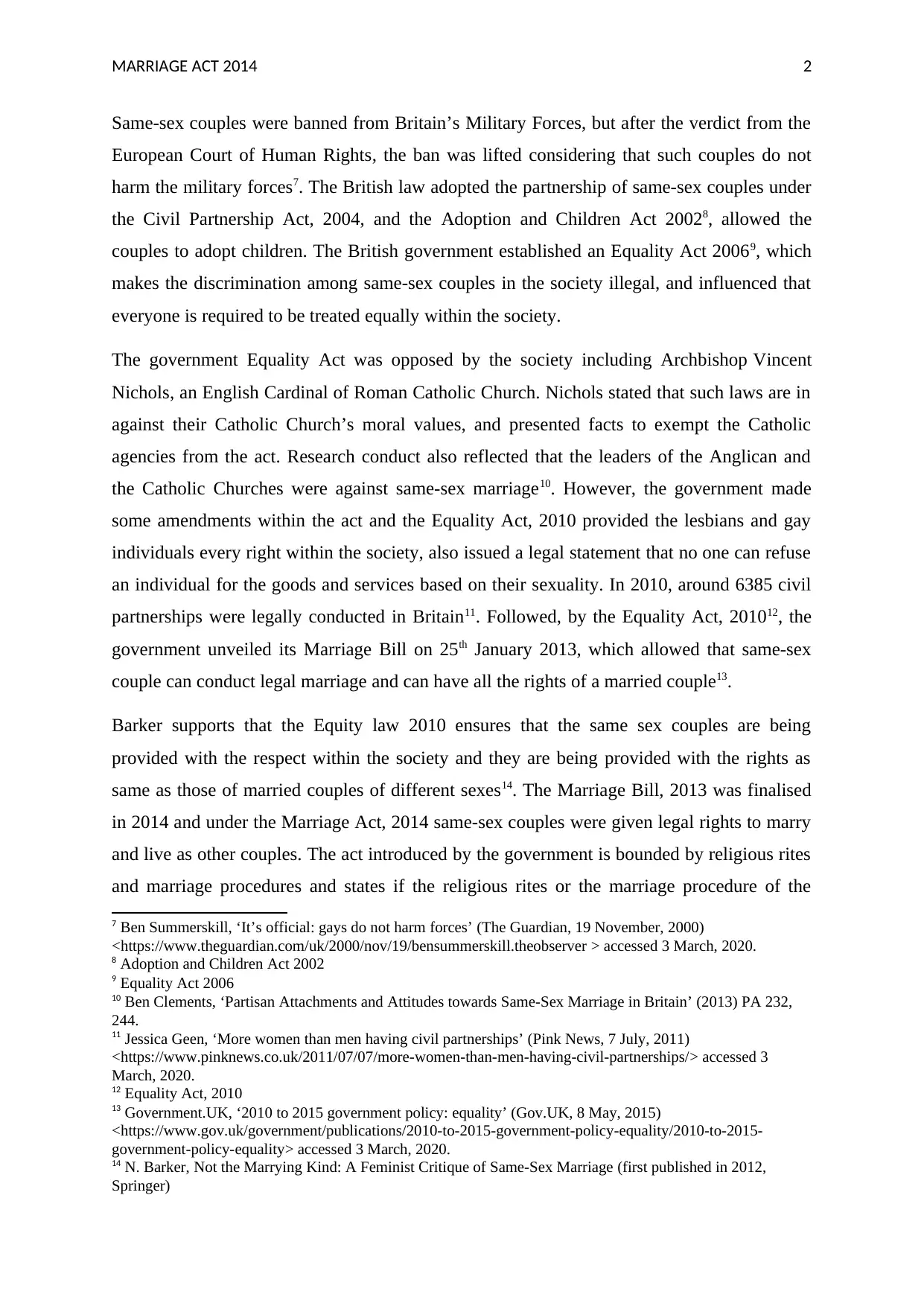
MARRIAGE ACT 2014 2
Same-sex couples were banned from Britain’s Military Forces, but after the verdict from the
European Court of Human Rights, the ban was lifted considering that such couples do not
harm the military forces7. The British law adopted the partnership of same-sex couples under
the Civil Partnership Act, 2004, and the Adoption and Children Act 20028, allowed the
couples to adopt children. The British government established an Equality Act 20069, which
makes the discrimination among same-sex couples in the society illegal, and influenced that
everyone is required to be treated equally within the society.
The government Equality Act was opposed by the society including Archbishop Vincent
Nichols, an English Cardinal of Roman Catholic Church. Nichols stated that such laws are in
against their Catholic Church’s moral values, and presented facts to exempt the Catholic
agencies from the act. Research conduct also reflected that the leaders of the Anglican and
the Catholic Churches were against same-sex marriage10. However, the government made
some amendments within the act and the Equality Act, 2010 provided the lesbians and gay
individuals every right within the society, also issued a legal statement that no one can refuse
an individual for the goods and services based on their sexuality. In 2010, around 6385 civil
partnerships were legally conducted in Britain11. Followed, by the Equality Act, 201012, the
government unveiled its Marriage Bill on 25th January 2013, which allowed that same-sex
couple can conduct legal marriage and can have all the rights of a married couple13.
Barker supports that the Equity law 2010 ensures that the same sex couples are being
provided with the respect within the society and they are being provided with the rights as
same as those of married couples of different sexes14. The Marriage Bill, 2013 was finalised
in 2014 and under the Marriage Act, 2014 same-sex couples were given legal rights to marry
and live as other couples. The act introduced by the government is bounded by religious rites
and marriage procedures and states if the religious rites or the marriage procedure of the
7 Ben Summerskill, ‘It’s official: gays do not harm forces’ (The Guardian, 19 November, 2000)
<https://www.theguardian.com/uk/2000/nov/19/bensummerskill.theobserver > accessed 3 March, 2020.
8 Adoption and Children Act 2002
9 Equality Act 2006
10 Ben Clements, ‘Partisan Attachments and Attitudes towards Same-Sex Marriage in Britain’ (2013) PA 232,
244.
11 Jessica Geen, ‘More women than men having civil partnerships’ (Pink News, 7 July, 2011)
<https://www.pinknews.co.uk/2011/07/07/more-women-than-men-having-civil-partnerships/> accessed 3
March, 2020.
12 Equality Act, 2010
13 Government.UK, ‘2010 to 2015 government policy: equality’ (Gov.UK, 8 May, 2015)
<https://www.gov.uk/government/publications/2010-to-2015-government-policy-equality/2010-to-2015-
government-policy-equality> accessed 3 March, 2020.
14 N. Barker, Not the Marrying Kind: A Feminist Critique of Same-Sex Marriage (first published in 2012,
Springer)
Same-sex couples were banned from Britain’s Military Forces, but after the verdict from the
European Court of Human Rights, the ban was lifted considering that such couples do not
harm the military forces7. The British law adopted the partnership of same-sex couples under
the Civil Partnership Act, 2004, and the Adoption and Children Act 20028, allowed the
couples to adopt children. The British government established an Equality Act 20069, which
makes the discrimination among same-sex couples in the society illegal, and influenced that
everyone is required to be treated equally within the society.
The government Equality Act was opposed by the society including Archbishop Vincent
Nichols, an English Cardinal of Roman Catholic Church. Nichols stated that such laws are in
against their Catholic Church’s moral values, and presented facts to exempt the Catholic
agencies from the act. Research conduct also reflected that the leaders of the Anglican and
the Catholic Churches were against same-sex marriage10. However, the government made
some amendments within the act and the Equality Act, 2010 provided the lesbians and gay
individuals every right within the society, also issued a legal statement that no one can refuse
an individual for the goods and services based on their sexuality. In 2010, around 6385 civil
partnerships were legally conducted in Britain11. Followed, by the Equality Act, 201012, the
government unveiled its Marriage Bill on 25th January 2013, which allowed that same-sex
couple can conduct legal marriage and can have all the rights of a married couple13.
Barker supports that the Equity law 2010 ensures that the same sex couples are being
provided with the respect within the society and they are being provided with the rights as
same as those of married couples of different sexes14. The Marriage Bill, 2013 was finalised
in 2014 and under the Marriage Act, 2014 same-sex couples were given legal rights to marry
and live as other couples. The act introduced by the government is bounded by religious rites
and marriage procedures and states if the religious rites or the marriage procedure of the
7 Ben Summerskill, ‘It’s official: gays do not harm forces’ (The Guardian, 19 November, 2000)
<https://www.theguardian.com/uk/2000/nov/19/bensummerskill.theobserver > accessed 3 March, 2020.
8 Adoption and Children Act 2002
9 Equality Act 2006
10 Ben Clements, ‘Partisan Attachments and Attitudes towards Same-Sex Marriage in Britain’ (2013) PA 232,
244.
11 Jessica Geen, ‘More women than men having civil partnerships’ (Pink News, 7 July, 2011)
<https://www.pinknews.co.uk/2011/07/07/more-women-than-men-having-civil-partnerships/> accessed 3
March, 2020.
12 Equality Act, 2010
13 Government.UK, ‘2010 to 2015 government policy: equality’ (Gov.UK, 8 May, 2015)
<https://www.gov.uk/government/publications/2010-to-2015-government-policy-equality/2010-to-2015-
government-policy-equality> accessed 3 March, 2020.
14 N. Barker, Not the Marrying Kind: A Feminist Critique of Same-Sex Marriage (first published in 2012,
Springer)
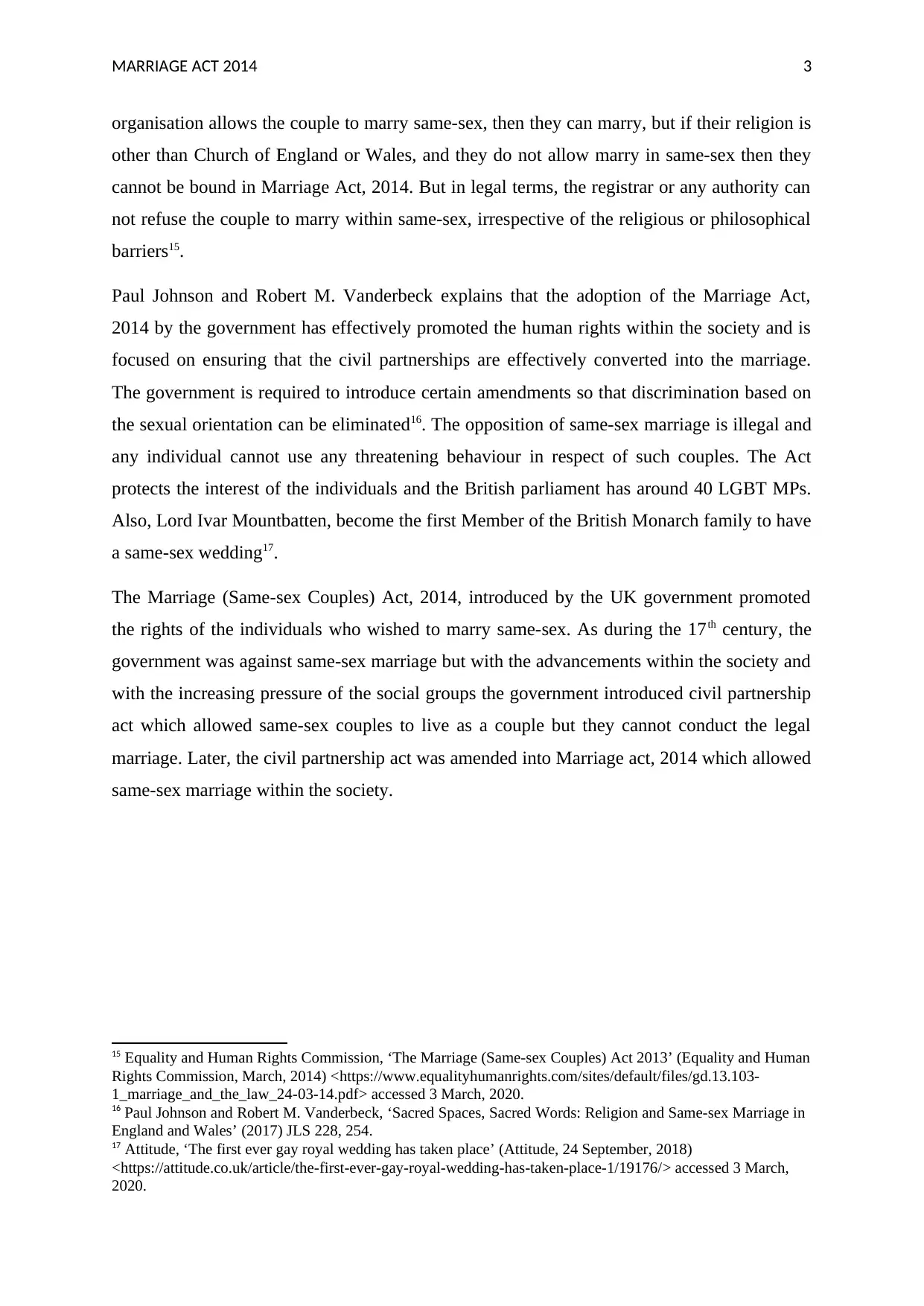
MARRIAGE ACT 2014 3
organisation allows the couple to marry same-sex, then they can marry, but if their religion is
other than Church of England or Wales, and they do not allow marry in same-sex then they
cannot be bound in Marriage Act, 2014. But in legal terms, the registrar or any authority can
not refuse the couple to marry within same-sex, irrespective of the religious or philosophical
barriers15.
Paul Johnson and Robert M. Vanderbeck explains that the adoption of the Marriage Act,
2014 by the government has effectively promoted the human rights within the society and is
focused on ensuring that the civil partnerships are effectively converted into the marriage.
The government is required to introduce certain amendments so that discrimination based on
the sexual orientation can be eliminated16. The opposition of same-sex marriage is illegal and
any individual cannot use any threatening behaviour in respect of such couples. The Act
protects the interest of the individuals and the British parliament has around 40 LGBT MPs.
Also, Lord Ivar Mountbatten, become the first Member of the British Monarch family to have
a same-sex wedding17.
The Marriage (Same-sex Couples) Act, 2014, introduced by the UK government promoted
the rights of the individuals who wished to marry same-sex. As during the 17th century, the
government was against same-sex marriage but with the advancements within the society and
with the increasing pressure of the social groups the government introduced civil partnership
act which allowed same-sex couples to live as a couple but they cannot conduct the legal
marriage. Later, the civil partnership act was amended into Marriage act, 2014 which allowed
same-sex marriage within the society.
15 Equality and Human Rights Commission, ‘The Marriage (Same-sex Couples) Act 2013’ (Equality and Human
Rights Commission, March, 2014) <https://www.equalityhumanrights.com/sites/default/files/gd.13.103-
1_marriage_and_the_law_24-03-14.pdf> accessed 3 March, 2020.
16 Paul Johnson and Robert M. Vanderbeck, ‘Sacred Spaces, Sacred Words: Religion and Same-sex Marriage in
England and Wales’ (2017) JLS 228, 254.
17 Attitude, ‘The first ever gay royal wedding has taken place’ (Attitude, 24 September, 2018)
<https://attitude.co.uk/article/the-first-ever-gay-royal-wedding-has-taken-place-1/19176/> accessed 3 March,
2020.
organisation allows the couple to marry same-sex, then they can marry, but if their religion is
other than Church of England or Wales, and they do not allow marry in same-sex then they
cannot be bound in Marriage Act, 2014. But in legal terms, the registrar or any authority can
not refuse the couple to marry within same-sex, irrespective of the religious or philosophical
barriers15.
Paul Johnson and Robert M. Vanderbeck explains that the adoption of the Marriage Act,
2014 by the government has effectively promoted the human rights within the society and is
focused on ensuring that the civil partnerships are effectively converted into the marriage.
The government is required to introduce certain amendments so that discrimination based on
the sexual orientation can be eliminated16. The opposition of same-sex marriage is illegal and
any individual cannot use any threatening behaviour in respect of such couples. The Act
protects the interest of the individuals and the British parliament has around 40 LGBT MPs.
Also, Lord Ivar Mountbatten, become the first Member of the British Monarch family to have
a same-sex wedding17.
The Marriage (Same-sex Couples) Act, 2014, introduced by the UK government promoted
the rights of the individuals who wished to marry same-sex. As during the 17th century, the
government was against same-sex marriage but with the advancements within the society and
with the increasing pressure of the social groups the government introduced civil partnership
act which allowed same-sex couples to live as a couple but they cannot conduct the legal
marriage. Later, the civil partnership act was amended into Marriage act, 2014 which allowed
same-sex marriage within the society.
15 Equality and Human Rights Commission, ‘The Marriage (Same-sex Couples) Act 2013’ (Equality and Human
Rights Commission, March, 2014) <https://www.equalityhumanrights.com/sites/default/files/gd.13.103-
1_marriage_and_the_law_24-03-14.pdf> accessed 3 March, 2020.
16 Paul Johnson and Robert M. Vanderbeck, ‘Sacred Spaces, Sacred Words: Religion and Same-sex Marriage in
England and Wales’ (2017) JLS 228, 254.
17 Attitude, ‘The first ever gay royal wedding has taken place’ (Attitude, 24 September, 2018)
<https://attitude.co.uk/article/the-first-ever-gay-royal-wedding-has-taken-place-1/19176/> accessed 3 March,
2020.
Secure Best Marks with AI Grader
Need help grading? Try our AI Grader for instant feedback on your assignments.
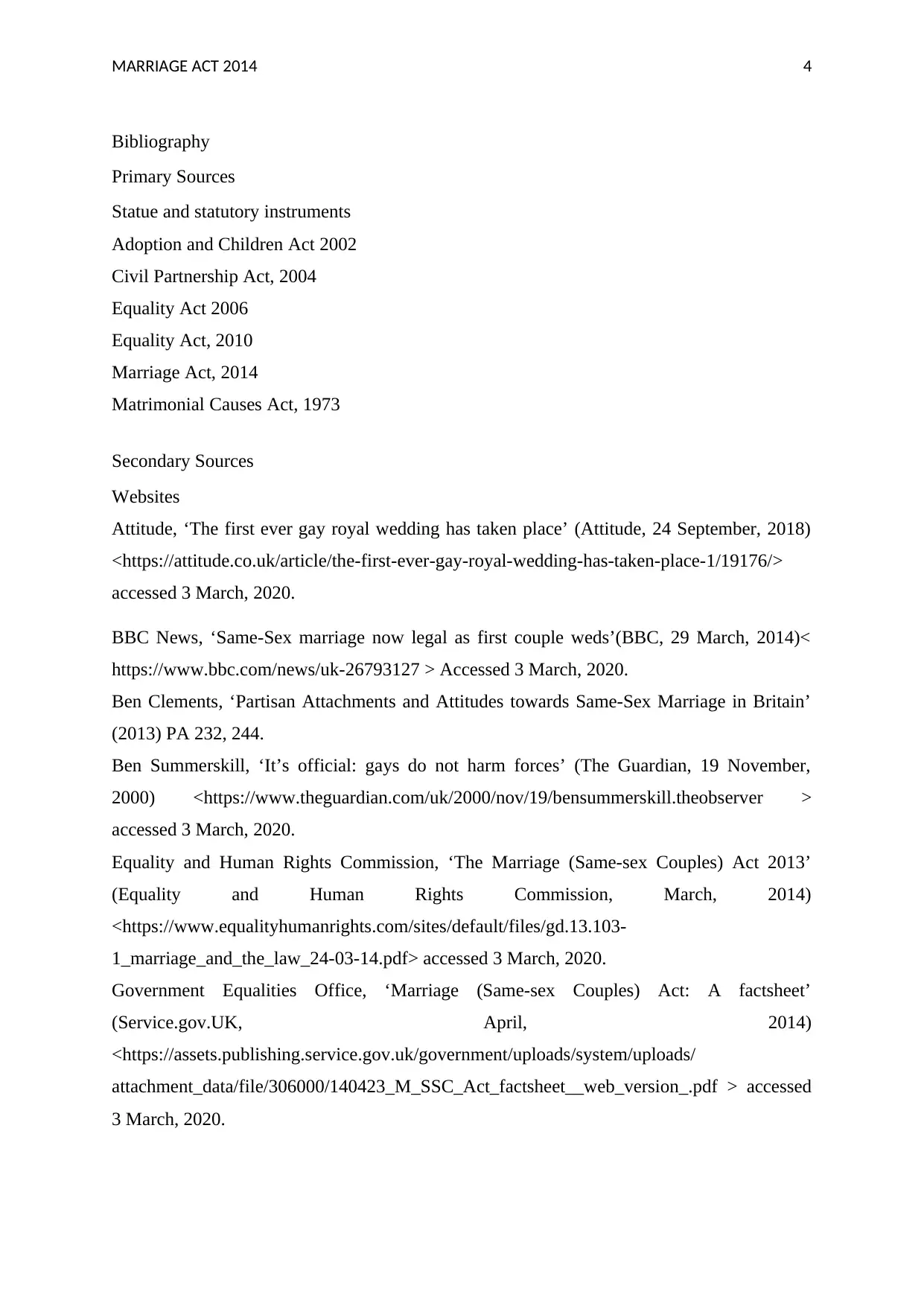
MARRIAGE ACT 2014 4
Bibliography
Primary Sources
Statue and statutory instruments
Adoption and Children Act 2002
Civil Partnership Act, 2004
Equality Act 2006
Equality Act, 2010
Marriage Act, 2014
Matrimonial Causes Act, 1973
Secondary Sources
Websites
Attitude, ‘The first ever gay royal wedding has taken place’ (Attitude, 24 September, 2018)
<https://attitude.co.uk/article/the-first-ever-gay-royal-wedding-has-taken-place-1/19176/>
accessed 3 March, 2020.
BBC News, ‘Same-Sex marriage now legal as first couple weds’(BBC, 29 March, 2014)<
https://www.bbc.com/news/uk-26793127 > Accessed 3 March, 2020.
Ben Clements, ‘Partisan Attachments and Attitudes towards Same-Sex Marriage in Britain’
(2013) PA 232, 244.
Ben Summerskill, ‘It’s official: gays do not harm forces’ (The Guardian, 19 November,
2000) <https://www.theguardian.com/uk/2000/nov/19/bensummerskill.theobserver >
accessed 3 March, 2020.
Equality and Human Rights Commission, ‘The Marriage (Same-sex Couples) Act 2013’
(Equality and Human Rights Commission, March, 2014)
<https://www.equalityhumanrights.com/sites/default/files/gd.13.103-
1_marriage_and_the_law_24-03-14.pdf> accessed 3 March, 2020.
Government Equalities Office, ‘Marriage (Same-sex Couples) Act: A factsheet’
(Service.gov.UK, April, 2014)
<https://assets.publishing.service.gov.uk/government/uploads/system/uploads/
attachment_data/file/306000/140423_M_SSC_Act_factsheet__web_version_.pdf > accessed
3 March, 2020.
Bibliography
Primary Sources
Statue and statutory instruments
Adoption and Children Act 2002
Civil Partnership Act, 2004
Equality Act 2006
Equality Act, 2010
Marriage Act, 2014
Matrimonial Causes Act, 1973
Secondary Sources
Websites
Attitude, ‘The first ever gay royal wedding has taken place’ (Attitude, 24 September, 2018)
<https://attitude.co.uk/article/the-first-ever-gay-royal-wedding-has-taken-place-1/19176/>
accessed 3 March, 2020.
BBC News, ‘Same-Sex marriage now legal as first couple weds’(BBC, 29 March, 2014)<
https://www.bbc.com/news/uk-26793127 > Accessed 3 March, 2020.
Ben Clements, ‘Partisan Attachments and Attitudes towards Same-Sex Marriage in Britain’
(2013) PA 232, 244.
Ben Summerskill, ‘It’s official: gays do not harm forces’ (The Guardian, 19 November,
2000) <https://www.theguardian.com/uk/2000/nov/19/bensummerskill.theobserver >
accessed 3 March, 2020.
Equality and Human Rights Commission, ‘The Marriage (Same-sex Couples) Act 2013’
(Equality and Human Rights Commission, March, 2014)
<https://www.equalityhumanrights.com/sites/default/files/gd.13.103-
1_marriage_and_the_law_24-03-14.pdf> accessed 3 March, 2020.
Government Equalities Office, ‘Marriage (Same-sex Couples) Act: A factsheet’
(Service.gov.UK, April, 2014)
<https://assets.publishing.service.gov.uk/government/uploads/system/uploads/
attachment_data/file/306000/140423_M_SSC_Act_factsheet__web_version_.pdf > accessed
3 March, 2020.
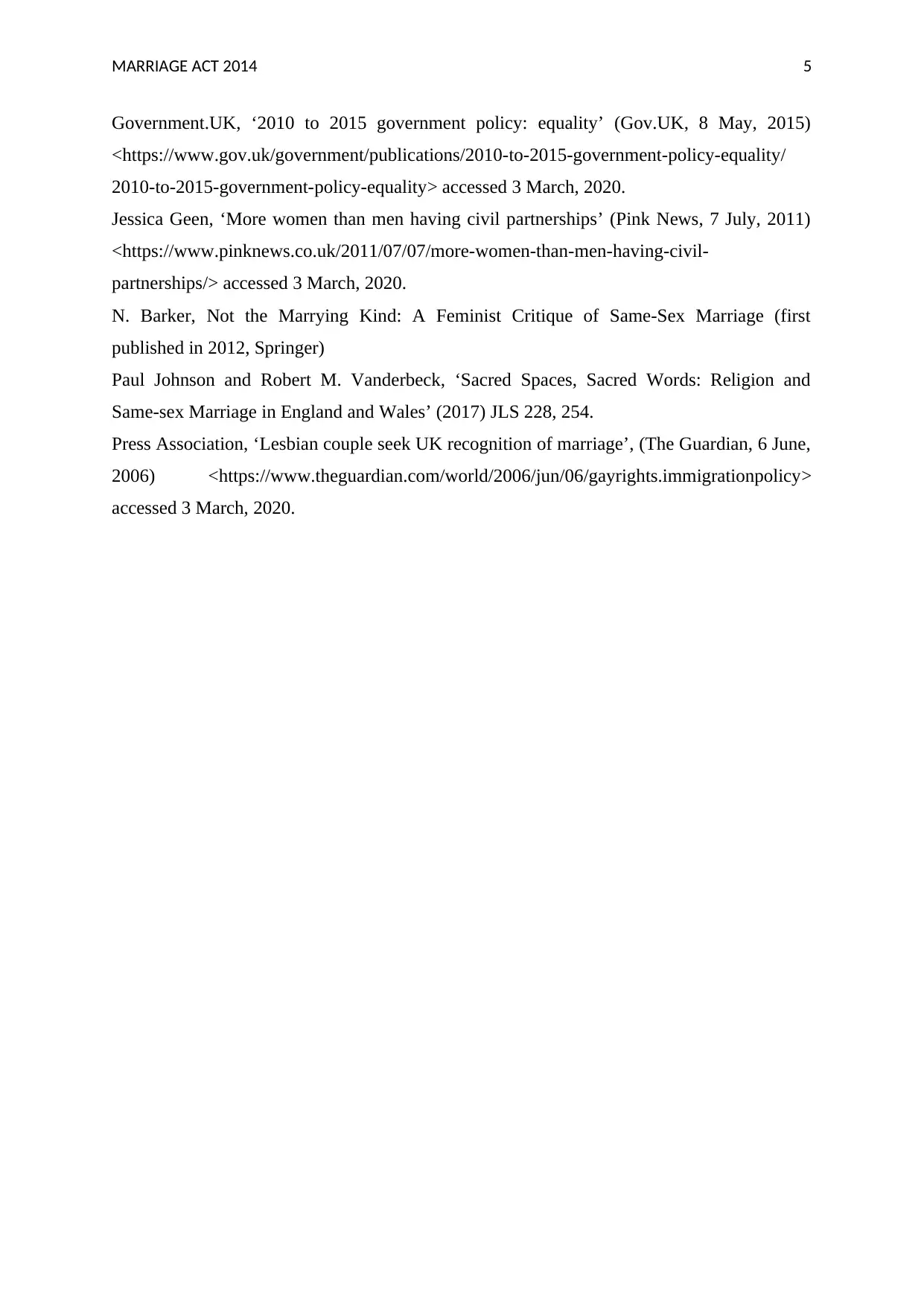
MARRIAGE ACT 2014 5
Government.UK, ‘2010 to 2015 government policy: equality’ (Gov.UK, 8 May, 2015)
<https://www.gov.uk/government/publications/2010-to-2015-government-policy-equality/
2010-to-2015-government-policy-equality> accessed 3 March, 2020.
Jessica Geen, ‘More women than men having civil partnerships’ (Pink News, 7 July, 2011)
<https://www.pinknews.co.uk/2011/07/07/more-women-than-men-having-civil-
partnerships/> accessed 3 March, 2020.
N. Barker, Not the Marrying Kind: A Feminist Critique of Same-Sex Marriage (first
published in 2012, Springer)
Paul Johnson and Robert M. Vanderbeck, ‘Sacred Spaces, Sacred Words: Religion and
Same-sex Marriage in England and Wales’ (2017) JLS 228, 254.
Press Association, ‘Lesbian couple seek UK recognition of marriage’, (The Guardian, 6 June,
2006) <https://www.theguardian.com/world/2006/jun/06/gayrights.immigrationpolicy>
accessed 3 March, 2020.
Government.UK, ‘2010 to 2015 government policy: equality’ (Gov.UK, 8 May, 2015)
<https://www.gov.uk/government/publications/2010-to-2015-government-policy-equality/
2010-to-2015-government-policy-equality> accessed 3 March, 2020.
Jessica Geen, ‘More women than men having civil partnerships’ (Pink News, 7 July, 2011)
<https://www.pinknews.co.uk/2011/07/07/more-women-than-men-having-civil-
partnerships/> accessed 3 March, 2020.
N. Barker, Not the Marrying Kind: A Feminist Critique of Same-Sex Marriage (first
published in 2012, Springer)
Paul Johnson and Robert M. Vanderbeck, ‘Sacred Spaces, Sacred Words: Religion and
Same-sex Marriage in England and Wales’ (2017) JLS 228, 254.
Press Association, ‘Lesbian couple seek UK recognition of marriage’, (The Guardian, 6 June,
2006) <https://www.theguardian.com/world/2006/jun/06/gayrights.immigrationpolicy>
accessed 3 March, 2020.
1 out of 6
Related Documents
Your All-in-One AI-Powered Toolkit for Academic Success.
+13062052269
info@desklib.com
Available 24*7 on WhatsApp / Email
![[object Object]](/_next/static/media/star-bottom.7253800d.svg)
Unlock your academic potential
© 2024 | Zucol Services PVT LTD | All rights reserved.





